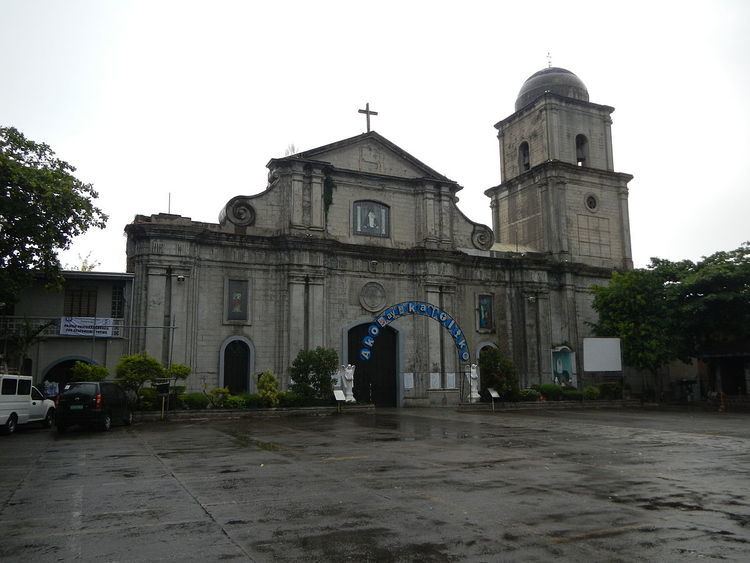Denomination Roman Catholic Website imusdiocese.net Opened 1853 Architectural style Earthquake Baroque | Phone +63 46 471 2686 | |
 | ||
Diocese Roman Catholic Diocese of Imus Similar St Mary Magdalene Church, Immaculate Conception Parish Ch, St Francis of Assisi Parish Ch, Bridge of Isabel II, Saint Gregory the Great | ||
The Cathedral of Our Lady of the Pillar, commonly known as the Imus Cathedral, is a Roman Catholic cathedral church in the city of Imus, in the province of Cavite, Philippines. It is the seat of the bishop of the Diocese of Imus, the diocese that has jurisdiction of all the Catholic parishes in Cavite. The patroness of the city and of the diocese is the Nuestra Señora del Pilar (Our Lady of the Pillar). Saint John the Baptist is also considered as a patron saint of the city. The city fiesta is celebrated annually every October 12. Part of the celebration is the traditional dance-procession called karakol.
Contents
Establishment
In 1616, the Augustinian Recollects arrived in Imus and established a convent. The parish of Imus started as a chapel-of-ease in Brgy. Toclong, a sub-parish (visita) of Cavite Viejo (now Kawit, Cavite). Recollect Father Pedro de San Buenaventura petitioned the government to convert Imus into an independent municipality in 1774. Imus, though, did not become a separate town and parish until October 3, 1795. Its poblacion (town center) and a provisional church was first established in Brgy. Bayang Luma (Old Town). The parish was under the order of the Augustinian Recollects with Francisco de Santiago, O.A.R., its first assigned priest.
Construction of the present church
During the leadership of Fr. Nicolas Becerra, who served from 1821 to 1840, he advocated the move of the town center to Brgy. Balangon, its present location. The construction of the parish church of Imus on the new location was started in 1823 using forced labor. The structure was made from stone and bricks. Its facade was patterned after the fifth Manila Cathedral by Fr. Juan de Uguccioni, which existed from 1760 to 1852.
Hacienda de San Juan de Imus
The early fathers were preoccupied with not just religious matters but also of economic concerns. The friars gradually bought parcels of land while some of these lands were donated by rich families. The Recollects were the first ones to buy parcels of land beginning in 1666 and their haciendas came to being in 1812. These areas, comprising the Hacienda de San Juan de Imus or the Hacienda de Imus (Imus Estate), grew to include the whole towns of Imus, Dasmariñas, and Brgy. Binakayan in Kawit. The estate house of the hacienda, or the house of the friars, was located along Imus River (at the present day Cuartel) at the southern end of the Bridge of Isabel II, a Spanish bridge built by the priest-engineers of the Recollects. Citizens of Imus were required to pay rent to live and tilled the lands of Imus.
Secularization
The Hacienda de Imus was sold by the Recollect Corporation on March 31, 1894 to the Fomento de la Agricultura de Filipinas (Promotion of Agriculture in the Philippines), a corporation in Madrid, for 4,000,000 pesetas. It was later sold to the British Manila Estates Company, which eventually sold it to the U.S. controlled Philippine government for $1,045,000 in U.S. currency for distribution to the Filipinos, to win their favor, and to pacify the revolutionaries. The Church of Imus became secular in 1897.
Diocese of Imus
By virtue of the Apostolic Constitution Christi fidelium promulgated by Pope John XXIII on November 25, 1961, Cavite was created a separate bishopric from Manila after more than three hundred years. On April 29, 1962, the Diocese of Imus was formally erected and established with the Imus Cathedral as the seat of the bishop of Cavite, with the Our Lady of the Pillar, its titular patroness. The first leader of the diocese and bishop of Cavite is Msgr. Artemio Casas, originally from Meycauayan, Bulacan.
Bishop of Imus
The current Bishop of Imus is the Most Rev. Reynaldo G. Evangelista, O.F.S., D.D. who was appointed by Pope Francis on April 8, 2013, his first pontifical appointment in the Philippines. He replaced Bishop Luis Tagle after his installation as the Archbishop of Manila in December 12, 2011. Most Rev. Evangelista was installed as the fifth Bishop of Imus on June 5, 2013.
Historical marker
The cathedral was declared a structure of historical significance with the placing of a historical marker by then National Historical Institute of the Philippines on November 13, 2006.
Coronation of the patroness of the Diocese of Imus
The image of the patroness of the Imus Cathedral, Our Lady of the Pillar of Imus, was canonically crowned on December 3, 2012 by Luis Antonio Cardinal Tagle. It was originally scheduled for November 26 but the elevation of Archbishop Tagle into a Cardinal by Pope Benedict XVI necessitated the move.
Vicariate of Our Lady of the Pillar
Vicariate of Our Lady of the Pillar (City of Imus) Vicar Forane: Rev Fr. Melencio Sandoval
